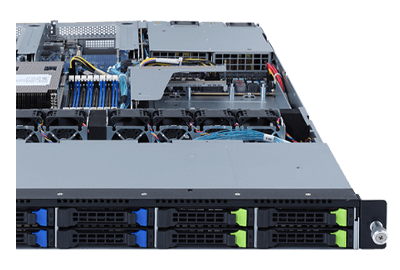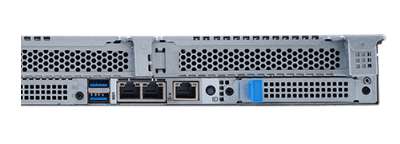Your shopping cart is empty

Buy Online or Call 800-237-0402
Search
Designed for use as a shared Internet connection, for file access via VPN, file storage or use as a virtual server, the Gigabyte R162-ZA1 server features 10x hot swap drive bays compatible with SAS, SATA or NVMe storage devices. Upon its initial release (rev.100) it supported either a 1st or second generation AMD EPYC CPU but with a firmware upgrade (rev.A00) it now supports a 3rd Gen AMD EPYC CPU.



Outfitted with a single AMD EPYC CPU from the third generation, the Gigabyte R162-ZA1 server provides up to 64x cores of processing power comparable to that of a dual processor intel-based system. With only a single processor it delivers a more rapid return on investment, and paired with Gigabytes free-of-charge management tools it offers superb value. At capacity it can provide up to 4TB of memory along with flexible storage options supporting SAS, SATA, and NVMe drive formats for a variety of standard networking applications. This platform is also compatible with the Graid MegaRAID card offering hardware RAID for NVMe storage devices. The system features dual 1GbE ports for basic network communications, which can be augmented by installing expansion cards. Powering the system are redundant dual 800W 80 PLUS platinum power Supplies.
With rev.100 this system originally supported 1st and 2nd generation AMD EPYC processors. However, with a firmware update (rev.A00) it can now support 3rd generation processors for greater levels of performance. Compute for certain tasks has been increased by up to 19% with changes to the microarchitecture within the CPU. Each processor also supports PCIe 4.0, plus 8x memory channels for a larger memory footprint.
When released, this system supported only 1st and 2nd generation AMD EPYC CPUs. Depending on the installed processor, 2nd generation processors provided up to 64x physical cores and 128x virtual threads, while first generation AMD EPYCs are limited to 32x physical cores and 64x virtual threads maximum. Both generations still provide PCIe 4.0 and 8x memory channels. Gen 2 processors also support a larger memory footprint compared to the first generation.
With a single CPU and 8x memory channel architecture, this system can support two DIMMs per channel for a total of 16x active memory module slots. Registered (RDIMM), Load-Reduced (LRDIMM) and 3Ds versions of RDIMMs and LRDIMMs are supported on this system. 3DS DIMMs will provide the greatest capacity at up to 4TB using 256GB memory modules in all 16x slots. Memory speeds of 2933MHz and 3200MHz are supported.

The 10x Storage bays on the front of the Gigabyte R162-ZA1 Server are color coded to indicate support for specific drive formats. 6x of the trays are blue indicating support for SAS and SATA drives. 4x drive bays on the right are green, with 2x reserved for NVMe drive formats exclusively and the other 2x capable of supporting NVMe or SAS/SATA devices. A GRAID SupremeRAID NVMe RAID card provides hardware support for up to 32x NVMe storage devices and removes the control burden from the CPU, reserving compute resources. A PCIe 4.0 x4 slot on the system board supports a single NVMe M.2 drive that can be used to support the OS. A SAS add-on card is required for SAS device support.
In total, there are 3x PCIe 4.0 x16 expansion slots for support of additional network interface controllers (NICs), for support of a SAS controller or for additional NVMe storage. Also supported is the GRAID SupremeRAID card offering a hardware RAID solution for NVMe storage devices. There are also two OCP mezzanine card slots at the rear of the chassis. One mezzanine slot supports an OCP 2.0 card with a PCIe 3.0 x8 interface, and the other supports an OCP 3.0 mezzanine card with a PCIe 4.0 x16 slot. As mentioned previously, a single M.2 drive can be installed in a dedicated PCIe 4.0 x4 slot on the system board.
Using the dedicated management LAN port in back, Administrators can connect to the integrated ASPEED AST2500 baseboard management controller for at chassis and remote management of the system. Gigabyte also provides a suite a management tools free of charge. To manage a single server or small cluster of servers, the Gigabyte Management Console comes pre-installed. For managing large groups or clusters of servers, there’s the Gigabyte Server Manager or GSM. GSM provides more tools and leverages the Gigabyte Management Console to provide inventory and status of the network assets form a single location remotely using a standard browser interface.
At only 1U, the Gigabyte R162-ZA1 server supports up to 10x hybrid drive bays for tiered storage. 3rd generation Intel Xeon Scalable processors enable faster compute and can provide support for up to 4TB of memory at capacity. This platform offers a flexible and adaptable set of features to support the standard networking applications of a growing business.
If you know what you want but can't find the exact configuration you're looking for, have one of our knowledgeable sales staff contact you. Give us a list of the components you would like to incorporate into the system, and the quantities, if more than one. We will get back to you immediately with an official quote.